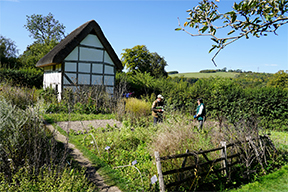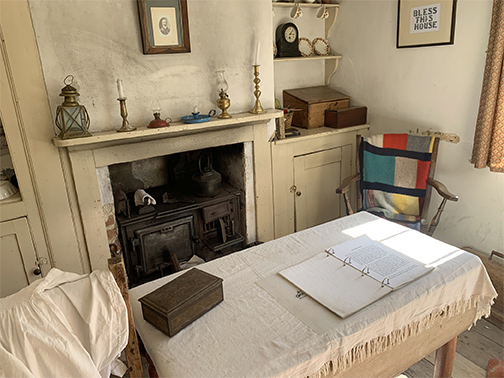Adam Abroad: A Report from Sussex
By Executive Director Adam R. Moore
 After returning my daughter, Isabel, to Falmouth University in Cornwall, England, I had the opportunity to visit two significant properties in Sussex. Thanks to my friends and hosts Roger and Elizabeth Hunt of Vineyard Haven and of Pulborough, Sussex, I was able to visit both the Weald & Downland Museum and the Knepp Estate.
After returning my daughter, Isabel, to Falmouth University in Cornwall, England, I had the opportunity to visit two significant properties in Sussex. Thanks to my friends and hosts Roger and Elizabeth Hunt of Vineyard Haven and of Pulborough, Sussex, I was able to visit both the Weald & Downland Museum and the Knepp Estate.
The Weald & Downland Museum of Singleton, Chichester, is a collection of traditional English buildings that range in age over 1,000 years. Here, Roger Hunt had arranged for an extensive tour led by Lucy Hockley, who is the Cultural Engagement Manager for the Museum, and a meeting with Simon Wardell, the Museum Director. The presentation of many of the Museum’s historic buildings are relevant to the Hancock-Mitchell House at Quansoo Farm. For example, some houses are presented in such a fashion that, in certain rooms, a visitor can view what is inside a wall – the wattle and daub, the framing, the hurricane braces – whereas in other rooms, the visitor will see the room finished according to the style of the time.
At the 3,500-acre Knepp Estate in Horsham, West Sussex, Elizabeth Hunt had arranged a safari tour of the “rewilding” of this property. The rewilding of this agricultural estate is documented in the book Wilding by Isabella Tree. Ms. Tree owns the estate with her husband, Charlie Burrell, and she had made arrangements for the safari of Knepp Wildland, which was led by ecologist Rina Quinlan. On the tour, we saw examples of how this former farm is returning to a natural state. In some areas, farm animals, such as Tamworth hogs, are allowed to roam freely, and serve as a more manageable proxy for wild boar. In other areas, native – but extirpated – magnificent white storks circle about overhead. With white storks, Knepp Wildland is trying to help white storks breed once again in Britain, something that has not happened for hundreds of years.
 Those seeking more information on the Weald & Downland Museum may visit the Museum’s website at www.wealddown.co.uk. Those seeking more information on Knepp Wildland may visit the Estate’s website at www.knepp.co.uk. I offer my sincere thanks and appreciation to Roger and Elizabeth Hunt for hosting me and arranging these very educational tours, and to Lucy Hockley and Simon Wardell at the Weald & Downland Museum, and to Rina Quinlan and Isabella Tree at Knepp Wildland.
Those seeking more information on the Weald & Downland Museum may visit the Museum’s website at www.wealddown.co.uk. Those seeking more information on Knepp Wildland may visit the Estate’s website at www.knepp.co.uk. I offer my sincere thanks and appreciation to Roger and Elizabeth Hunt for hosting me and arranging these very educational tours, and to Lucy Hockley and Simon Wardell at the Weald & Downland Museum, and to Rina Quinlan and Isabella Tree at Knepp Wildland.

